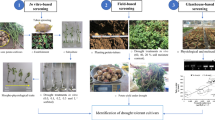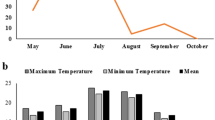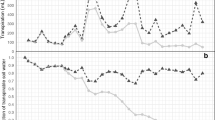Abstract
Potato production in Uganda is being affected by rainfall fluctuations in both timing and amount, resulting into inadequate soil moisture availability and low productivity. Also, potato production is expanding into locations at lower altitudes, where drought is more common. Therefore, drought stress mitigation measures and coping mechanisms need to be devised to face future challenges of climate change, particularly in developing countries to ensure steady supply of adequate quantities of quality food. This study thus, aimed at characterizing new potato clones from CIP (International Potato Center) for tolerance to drought under Ugandan conditions. Consequently a screen house experiment was conducted twice at Kachwekano Zonal Agricultural Research and Development Institute (KAZARDI) from October 2011 to February 2012 and April to July 2012 to evaluate and characterize eight potato genotypes; five of which were obtained from CIP’s breeding collection for drought tolerance and low altitude areas, and three locally released varieties from Uganda. These clones were tested for drought tolerance at three levels of simulated moisture deficit; 25 % field capacity, 50 % and 100 % field capacity (FC). Data were collected on leaf chlorophyll content, relative leaf water content, number of days to 50 % flowering, percent ground cover, leaf area, plant height, number of stems per plant, stem diameter, stress score, increment in plant height after imposing stress, tuber dry matter content and yield components. Of all the traits evaluated, yield and number of days to 50 % flowering contributed most to drought tolerance among the potato genotypes evaluated. There were significant (P ≤ 0.05) differences among genotypes for all evaluated traits. Results from both growth, physiological and yield parameters revealed that the new potato clones were less affected by drought stress compared to adapted varieties. Total tuber yield was 23 tons per hectare, 11.4 and 8.1 in plots at full field capacity, 50 % and 25 % moisture stressed plots respectively in the first experiment. A similar trend was obtained in the second experiment with 19 tons per hectare, 13.7 and 11.3 respectively. The new clones at highest moisture stress had significantly (P ≤ 0.05) higher yields than adapted varieties providing a promise for possible new varieties and breeding stock in extreme conditions of moisture deficit.
Resumen
La producción de papa en Uganda esta siendo afectada por fluctuaciones de lluvia, tanto en tiempo como en cantidad, lo cual resulta en una disponibilidad inadecuada de humedad en el suelo y baja productividad. También, se esta expandiendo la producción de papa en localidades a bajas altitudes, donde la sequía es más común. De aquí que las medidas de mitigación del agobio hídrico y los mecanismos para hacerle frente necesitan idearse para encarar futuros retos de cambio climático, particularmente en países en desarrollo, para asegurar un suministro constante de cantidades adecuadas de alimento de calidad. Este estudio, en consecuencia, esta dirigido a la caracterización de clones nuevos de papa del CIP (Centro Internacional de la Papa) para tolerancia a sequía bajo las condiciones de Uganda. Consecuentemente, se condujo un experimento de invernadero por duplicado en el Instituto Regional Kachwekano de Investigación y Desarrollo Agrícola (KAZARDI), de octubre de 2011 a febrero de 2012, y de abril a julio del 2012, para evaluar y caracterizar ocho genotipos de papa; cinco de los cuales se obtuvieron de la colección del mejoramiento del CIP para tolerancia a la sequía y a áreas de baja altitud, y tres variedades liberadas localmente de Uganda. Estos clones se probaron para tolerancia a la sequía a tres niveles de déficit de humedad simulado; 25 % de capacidad de campo, 50 % y 100 % de capacidad de campo (FC). Se obtuvieron datos del contenido de clorofila de la hoja, el contenido relativo del agua en la hoja, número de días para el 50 % de floración, porcentaje de cubierta del suelo, área foliar, altura de planta, número de tallos por planta, diámetro del tallo, nivel de agobio, incremento en la altura de la planta después de la exposición al estrés, contenido de materia seca del tubérculo, y componentes del rendimiento. De todas las variables evaluadas, el rendimiento y el número de días al 50 % de la floración, fueron los que más contribuyeron a la tolerancia a la sequía entre los genotipos de papa evaluados. Hubo diferencias significativas (P ≤ 0.05) entre los genotipos para todas las variables evaluadas. Los resultados tanto de crecimiento como de los parámetros fisiológicos y de rendimiento revelaron que los clones nuevos de papa fueron menos afectados por el agobio hídrico comparados con las variedades adaptadas. El rendimiento total del tubérculo fue de 23 ton/ha, 11.4 y8.1 en lotes a capacidad de campo total, 50 % y 25 % de agobio de humedad, respectivamente, en el primer experimento. En el segundo experimento se obtuvo una tendencia similar con 19 ton/ha, 13.7 y 11.3, respectivamente. Los nuevos clones expuestos al más alto agobio de humedad tuvieron más alto rendimiento significativamente (P ≤ 0.05) que las variedades adaptadas, proporcionando una promesa para posibles nuevas variedades y material de mejoramiento en condiciones extremas de déficit de humedad.

Similar content being viewed by others
References
Arunyanark, A., S. Jogloy, C. Akasaeng, N. Vorasoot, T. Kesmala, R.C. Nageswara, G.C. Wright, and A. Patanothai. 2009. Chlorophyl stability is an indicator of drought tolerance in peanut. Journal of Agronomy and Crop Science 194: 113–125.
Brans, H.D., and P.E. Weatherley. 1962. A re-examination of the relative turgidity technique for estimating water deficits in leaves. Australian Journal of Biological Sciences 15: 413–458.
Boyer, J.S., R.A. James, R. Munns, A.G. Condon, and J.B. Passioura. 2008. Osmotic adjustment may lead to anomalously low estimates of relative water content in wheat and barley. Functional Plant Biology 35: 1172–1182.
Ekanayake, I. J., 1990. Evaluation of potato and sweet potato genotypes for drought resistance. CIP Research Guide 19. International potato centre, Lima, Peru.9–12.
Hassanpanah, D., 2010. Evaluation of potato advanced cultivars against water deficit stress under in vitro and in vivo conditions. Biotechnology : 164–9.
IITA-FOODNET, CIP, PRAPACE, CGIAR and ASARECA, 2001.Uganda’s Irish Potato Sector
Jones, H. J, 1993. Drought tolerance and water-use efficiency. In Water deficits, plant response from cell to community. Oxford, UK: BIOS Scientific Publishers, pp. 193–203.
Kumar, R., G.S. Kang, and S.K. Pandey. 2007. Inheritance of resistance to late blight (Phytophthora infestans) in potato. Euphytica 155: 183–191.
Miyashita, K., S. Tanakamaru, M.T. Maitani, and M.K. Kimura. 2005. Recovery responses of photosynthesis, transpiration and stomatal conductance in kidney bean following drought stress. Environmental and Experimental Botany 53: 205–214.
Namazzi, B. S., 2011. Analysis of drought tolerance in selected upland rice genotypes in Uganda. M.Sc. Thesis Makerere University, Uganda, pp 53–57.
Sharma, N., P. Kumar, M.S. Kadian, S.K. Pandey, S.V. Singh, and S.K. Luthra. 2011. Performance of potato (SolanumtuberosumL) clones under stress, CIP south west and central Asia Region, New Delhi 110012. Indian Journal of Agricultural Sciences 81(9): 825–829.
Nolte, P., J.S. Miller, B.D. Geary, and D.L. Corsini. 2003. “Disease management”, chapter 10. In Potato production systems, ed. J.C. Stark and S.L. Love. Moscow: Agricultural Communications, University of Idaho. 426 pp.
PRAPACE, 1996. Evaluation of potato germplasm for field resistance to late blight in Eastern and Central Africa. Recommendations and Summaries from regional workshop presentations at Mukono, Uganda 21Pp.
Price, A., J. Cairns, P. Horton, H. Jones, and H. Griffiths. 2002. Linking drought-resistance mechanisms to drought avoidance in upland rice using a QTL approach: progress and new opportunities to integrate stomatal and medophyll responses’. Journal of Experimental Botany 53(371): 989–1004.
Schafleitner, R., R. Gutierrez, R. Espino, A. Gaudin, and J. Perez. 2007. Field screening for variation of drought tolerance in Solanum tuberosumL. by agronomical, Physiol., Genet. and Anal. Potato Research 50: 71–85.
Shakeel, A.A., Long-Chang-Wang Xiao-yuXie, F.S. Muhammad, Chen Man, and Lei Wang. 2011. Morphological, physiological and biochemical responses of plants to drought stress. African Journal of Agricultural Research 6(9): 2026–2032.
Shao, H.B., L.Y. Chu, C.A. Jaleel, P. Manivannan, R. Panneerselvam, and M.A. Shao. 2009. Understanding water deficit stress-induced changes in the basic metabolism of higher Plants-biotechnologically and sustainably improving agriculture and the eco environment in arid regions of the globe. Critical Reviews of Biotechnology 29: 131–151.
Wandiga, 2004. Vulnerability to climate induced highland malaria in East Africa. Report of the Assessment of Impacts and Adaptation to Climate Change in Multiple Regions and Sectors (AIACC) Project.
Yaqoob, M. 2007. Chickpea (CicerarietinumL) germplasm screening and evaluation under drought prone environment. Post doctoral technical progress report. Pp.21
Acknowledgments
We are grateful to AGRA-(Alliance for green revolution in Africa) PASS Project (Grant Ref 2010 pass 025) which sponsored this study. We also appreciate International Potato Center (CIP) which provides improved potato germplasm to Kachwekano Zonal Agricultural Research and Development Institute (KAZARDI) that is mandated to do research on potato in Uganda. I obtained the materials used in this study from the clones that were received for drought and for adaptation to low altitude areas where drought is more prone. Sincere appreciation goes to all the entire staff of KAZARDI for providing the screenhouse and several other materials for use during this study and human personnel that did the watering.
Author information
Authors and Affiliations
Corresponding author
Rights and permissions
About this article
Cite this article
Kesiime, V.E., Tusiime, G., Kashaija, I.N. et al. Characterization and Evaluation of Potato Genotypes (Solanum tuberosum L) for Tolerance to Drought in Uganda. Am. J. Potato Res. 93, 543–551 (2016). https://doi.org/10.1007/s12230-016-9533-5
Published:
Issue Date:
DOI: https://doi.org/10.1007/s12230-016-9533-5




